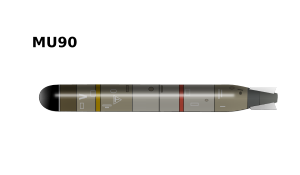MU90 Impact
| MU90 Impact | |
|---|---|
 |
|
| Type | torpedo |
| Place of origin |
Italy France |
| Service history | |
| Used by | Germany, France, Italy, India, Denmark, Australia and Poland |
| Production history | |
| Manufacturer | EuroTorp |
| Unit cost | €1.6m (~US$2.1m)(FY12) |
| Number built | >1000 |
| Variants | MU90 Hard Kill |
| Specifications | |
| Weight | 304 kg (670 lb) |
| Length | 2.85 m (112 in) |
| Diameter | 323.7 mm (12.74 in) |
|
|
|
| Warhead | PBX shaped charge warhead |
| Warhead weight | 32.7 kg |
|
|
|
| Engine |
Pump-jet Electric |
|
Operational
range |
>10 km (5.4 nmi) (max speed) >23 km (12 nmi) (min speed) |
| Maximum depth | >1000 m |
| Speed | 29 kn (54 km/h) to well over 50 kn (93 km/h) |
|
Guidance
system |
Active or passive acoustic homing |
The MU90/IMPACT is an advanced lightweight anti-submarine torpedo or 3rd generation developed by France and Italy for navies of France, Italy, Germany, Denmark, Australia and Poland. It is designed to compete with and outperform the US-built Mark 54 in the anti-submarine role, and has also been developed in a special MU90 Hard Kill version for torpedo anti-torpedo defence. The MU90 is built by EuroTorp, a consortium of French and Italian companies.
The MU90 was the result of separate projects in France and Italy from the 1980s. In France, a project under the direction of Thomson Sintra created the "Murène" in 1989, while in Italy Whitehead started work on an A244 replacement known as the A290. In 1990 the first attempts to merge the two efforts started, a process that was completed in 1993 with the formation of EuroTorp.
The French intended to use the new torpedo on their frigates, Atlantique 2 aircraft, Lynx helicopters and NFH90 helicopters. They originally wanted 1000 units, but the end of the Cold War saw their requirement cut to 600 in 1991, 450 in 2000 and finally 300 torpedoes in 2008. The project has cost France €1,150m (~US$1,500m) in 2012 prices at a unit cost of €1.6m (~US$2.1m), or €3.8m (~US$5m) including development costs. 25 torpedoes per year will be delivered to France until 2014.
The MU90 is capable against any current or perceived threat, including a bottomed stationary mini-submarine, known versions of anechoic coatings, and various decoys. It is also capable of launch speeds up to 400 knots, allowing it to be dropped from maritime patrol aircraft flying at high speeds, or rocket-assist launchers. Powered by an electric pump-jet, it can be run at "silent" speeds to avoid giving its location away to the submarine, or "dash" at speeds over 29 knots. It uses a shaped charge warhead that can penetrate any known submarine hull, especially Soviet double hull designs, while remaining just as deadly in shallow waters where conventional warheads are less effective.
...
Wikipedia
